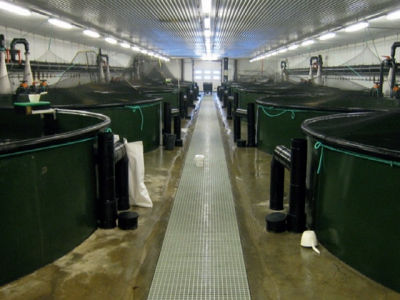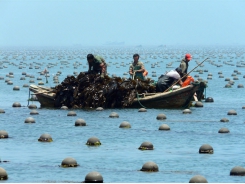A Guide to Recirculation Aquaculture - Part 1

An introduction to the new environmentally friendly and highly productive closed fish farming systems
Figure 1.1 An indoor recirculation system.
Chapter 1: Introduction to recirculation aquaculture
Recirculation aquaculture is essentially a technology for farming fish or other aquatic organisms by reusing the water in the production. The technology is based on the use of mechanical and biological filters, and the method can in principle be used for any species grown in aquaculture such as fish, shrimps, clams, etc. Recirculation technology is however primarily used in fish farming, and this guide is aimed at people working in this field of aquaculture. Recirculation is growing rapidly in many areas of the fish farming sector, and systems are deployed in production units that vary from huge plants generating many tonnes of fish per year for consumption to small sophisticated systems used for restocking or to save endangered species. Recirculation can be carried out at different intensities depending on how much water is recirculated or re-used. Some farms are super intensive farming systems installed inside a closed insulated building using as little as 300 litres of new water, and sometimes even less, per kilo of fish produced per year. Other systems are traditional outdoor farms that have been rebuilt into recirculated systems using around 3 m3 new water per kilo of fish produced per year. A traditional flowthrough system for trout will typically use around 30 m3 per kilo of fish produced per year. As an example, on a fish farm producing 500 tonnes of fish per year, the use of new water in the examples given will be 17 m3 /hour(h), 171 m3 /h and 1 712 m3 /h respectively, which is a huge difference.
Another way of calculating the degree of recirculation is using the formula: (Internal recirculation flow/(internal recirculation flow + new water intake)) x 100
Seen from an environmental point of view, the limited amount of water used in recirculation is of course beneficial as water has become a limited resource in many regions. Also, the limited use of water makes it much easier and cheaper to remove the nutrients excreted from the fish as the volume of discharged water is much lower than that discharged from a traditional fish farm. Recirculation aquaculture can therefore be considered a most environmentally friendly way of producing fish at a commercially viable level. The nutrients from the farmed fish can be used as fertilizer on agricultural farming land or as a basis for biogas production.
The term “zero-discharge” is sometimes used in connection to fish farming, and although it is possible to avoid all discharge from the farm of all sludge and water, the waste water treatment of the very last concentrations is most often a costly affair to clean off completely. Thus an application for discharging nutrients and water should always be part of the planning permission application.

Figure 1.3 An outdoor recirculation farm.
Most interesting though, is the fact that the limited use of water gives a huge benefit to the production inside the fish farm. Traditional fish farming is totally dependent on external conditions such as the water temperature of the river, cleanliness of the water, oxygen levels, or weed and leaves drifting downstream and blocking the inlet screens, etc. In a recirculated system these external factors are eliminated either completely or partly, depending on the degree of recirculation and the construction of the plant.
Recirculation enables the fish farmer to completely control all the parameters in the production, and the skills of the farmer to operate the recirculation system itself becomes just as important as his ability to take care of the fish.
Controlling parameters such as water temperature, oxygen levels, or daylight for that matter, gives stable and optimal conditions for the fish, which again gives less stress and better growth. These stable conditions result in a steady and foreseeable growth pattern that enables the farmer to precisely predict when the fish will have reached a certain stage or size. The major advantage of this feature is that a precise production plan can be drawn up and that the exact time the fish will be ready for sale can be predicted. This favours the overall management of the farm and strengthens the ability to market the fish in a competitive way.

Figure 1.4 Some of the parameters affecting the growth and well-being of a fish.
There are many more advantages of using recirculation technology in fish farming, and this guide will deal with these aspects in the following chapters. However, one major aspect to be mentioned right away is that of diseases. The impact of pathogens is lowered considerably in a recirculation system as invasive diseases from the outside environment are minimised by the limited use of water. Water for traditional fish farming is taken from a river, a lake or the sea, which naturally increases the risk of dragging in diseases. Due to the limited use of water in recirculation the water is mainly taken from a borehole, drainage system or spring where the risk of diseases is minimal. In fact, many recirculation systems do not have any problems with diseases whatsoever, and the use of medicine is therefore reduced significantly for the benefit of the production and the environment. To reach this level farming practice it is of course extremely important that the fish farmer is very careful about the eggs or fry that he brings on to his farm. Many diseases are carried into systems by taking in infested eggs or fish for stocking. The best way to avoid diseases entering this way, is not to bring in fish from outside, but only bring in eggs as these can be disinfected completely from diseases.
Aquaculture requires knowledge, good husbandry, persistence and sometimes nerves of steel. Shifting from traditional fish farming into recirculation does make many things easier, however at the same time it requires new and greater skills. To be successful in this quite advanced type of aquaculture calls for training and education for which purpose this guide has been written.
Related news
Tools

Phối trộn thức ăn chăn nuôi

Pha dung dịch thủy canh

Định mức cho tôm ăn

Phối trộn phân bón NPK

Xác định tỷ lệ tôm sống

Chuyển đổi đơn vị phân bón

Xác định công suất sục khí

Chuyển đổi đơn vị tôm

Tính diện tích nhà kính

Tính thể tích ao




 A Guide to Recirculation Aquaculture - Part 2
A Guide to Recirculation Aquaculture - Part 2  Responsible Consumption and Production of Farmed Seafood
Responsible Consumption and Production of Farmed Seafood